
Day
3 , April 7, 2003 - Monday
London to Canterbury
We ate breakfast in the Carvery in
the Thistle hotel, checked out and took at taxi to Victoria Station. A
nice man helped us figure out which train to take to Canterbury. We
missed the 9:05 by a minute. We
caught the next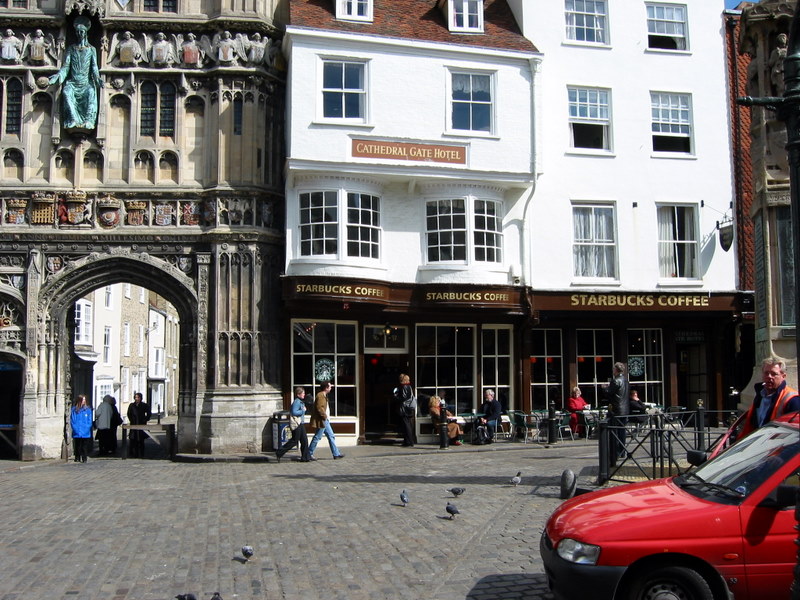 train,
and had to change trains at Faversham. We
arrived in Canterbury and took a taxi to the hotel.
train,
and had to change trains at Faversham. We
arrived in Canterbury and took a taxi to the hotel.
We had made reservations in Canterbury
Gate Hotel because the information said it was next to the CANTERBURY
CATHEDRAL
(model). Actually
the hotel was part of the wall round the cathedral and right next to the
gate to the cathedral grounds. The
hotel was built in 1438. The
whole first floor was occupied by Starbucks. We
found this somewhat unsettling even though we love Starbucks. We
climbed some steep steps through a door next to Starbucks. We
checked in and were told that we had to go up a few steps, through a
door onto the roof, cross the roof to another door. Upon
entering that door we found a small sitting room and a long hallway that
sloped to one side and then the other as we walked it. Then
we took a small elevator to the next floor. The
door to our room matched the slop of the hallway.  The room was small with a large bed. The
view was unbelievab
The room was small with a large bed. The
view was unbelievab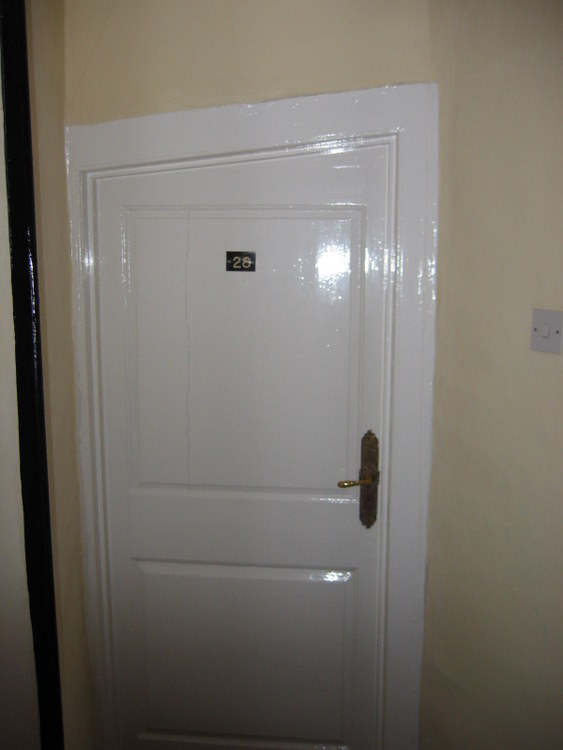
le. We were
right opposite the Bell Harry Bell Tower of the Cathedral. We
were so close to the cathedral we couldn’t capture the entire view. The
tower was well lit at night and we could lie in our beds and see the
breathtaking view. The
pulpit at the Washington Cathedral is made from stone that was left over
after the tower was remodeled in the early 1900s. I
would lay there and wonder just where that stone had been.
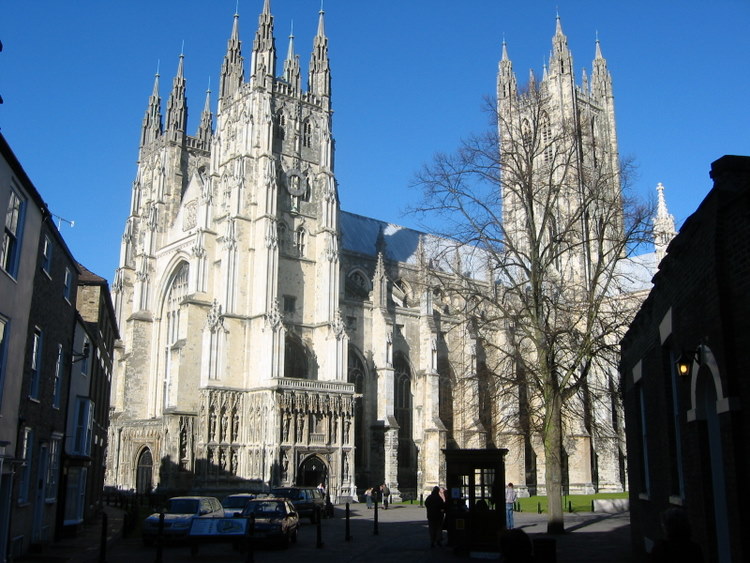
It was a nice day. There
were several groups of students in the square outside our hotel waiting
to take a tour of the cathedral. We found a little
cafeteria in the basement of a building across from the cathedral gate. We
were served rather than self service. We
love to tell the story about the young man serving us, who asked us if
we wanted “pies” with our meal. We
couldn’t understand what he was saying so he took the top off the
serving pan and there were “peas”. As
a fond remembrance of this experience, we most always call peas “pies”
when we serve them for dinner. After lunch we shopped around waiting for
our appointment time at the cathedral.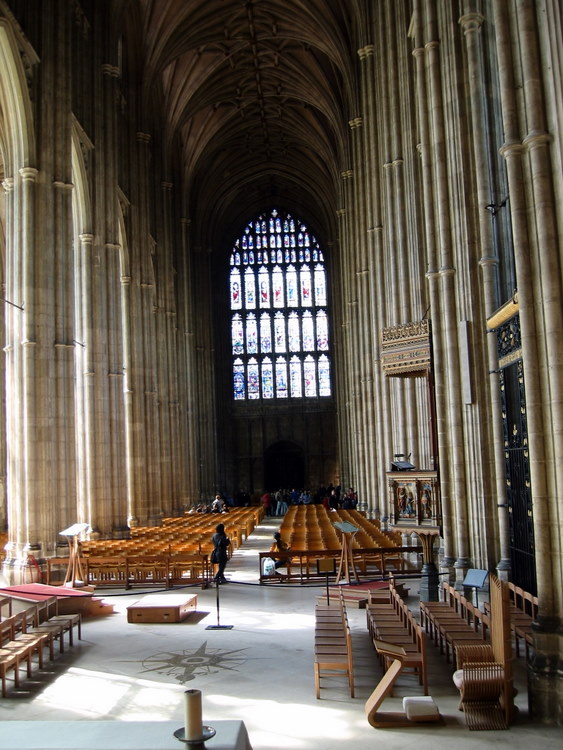
At our scheduled time, we stopped in the
cathedral’s visitors office and introduced ourselves as we had written
for a private tour and had reservations. Margaret
Hudson was our guide. She
took us into the cathedral and explained 
some of the history as she led us to the office of the person in
charge of the vestments (vestiturer). He
had an office in what was known as the ‘candle room”. There
was a small window that looked down on a chapel in the crypt below. He
told us that this was the room where the monks stayed to watch the body
of the murdered Thomas a Becket which was in the chapel below. One
of the cathedral canons joined us at this point. We
went into the vestment room or sacristy. The
vestiturer showed us all the old altar hangings and vestments. In
one closet was the cope of the Archbishop of Canterbury. The
cope is the final vestment that a bishop wears during religious
ceremonies. It looks like a big cape. He
had me put it on and have my picture taken. The
three of our guides continued to give us our private tour of the
Canterbury Cathedral.
 Canterbury
Cathedral is about the same size as the Washington Cathedral.
The profile on the left is the Washington Cathedral which is 100 feet
high compared with Canterbury which is only 70 feet high. Both
cathedrals, which are Gothic in
style have an open triforium and
stained glass windows in the clerestory.
Canterbury
Cathedral is about the same size as the Washington Cathedral.
The profile on the left is the Washington Cathedral which is 100 feet
high compared with Canterbury which is only 70 feet high. Both
cathedrals, which are Gothic in
style have an open triforium and
stained glass windows in the clerestory.
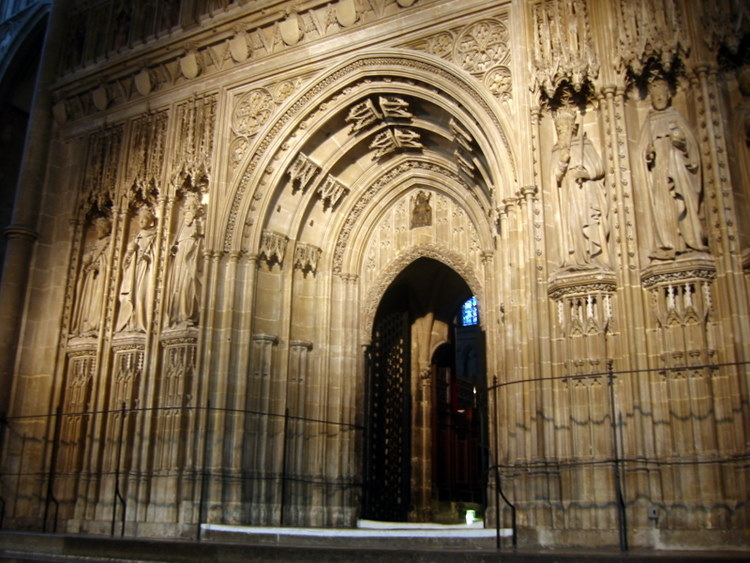
As with Westminster Abbey, there is a rood or
choir (quire) screen between the nave and the choir. Even
though it has a door in the center, it does not give a person standing
at the entrance a clear view of the high altar. Please
refer to Westminster
Abbey for an explanation
of Quire screen or as is sometimes called, the pulpitum. One
of the reasons that Westminster Abbey and Canterbury Cathedral have not
removed the Rood Screen as other Gothic Cathedrals have is because the
pipes of the organ are on top of the quire screen.
A LITTLE
HISTORY OF CANTERBURY CATHEDRAL.
In
597 Gregory the Great sent Augustine to England to Christianize Britain. Augustine
landed in Kent where he found King Ethelbert, who was married to Bertha,
a Christian. Ethelbert
gave Augustine land in Canterbury for a monastery. It
wasn’t long before Ethelbert and his knights were baptized. Augustine
became the first Archbishop of Canterbury.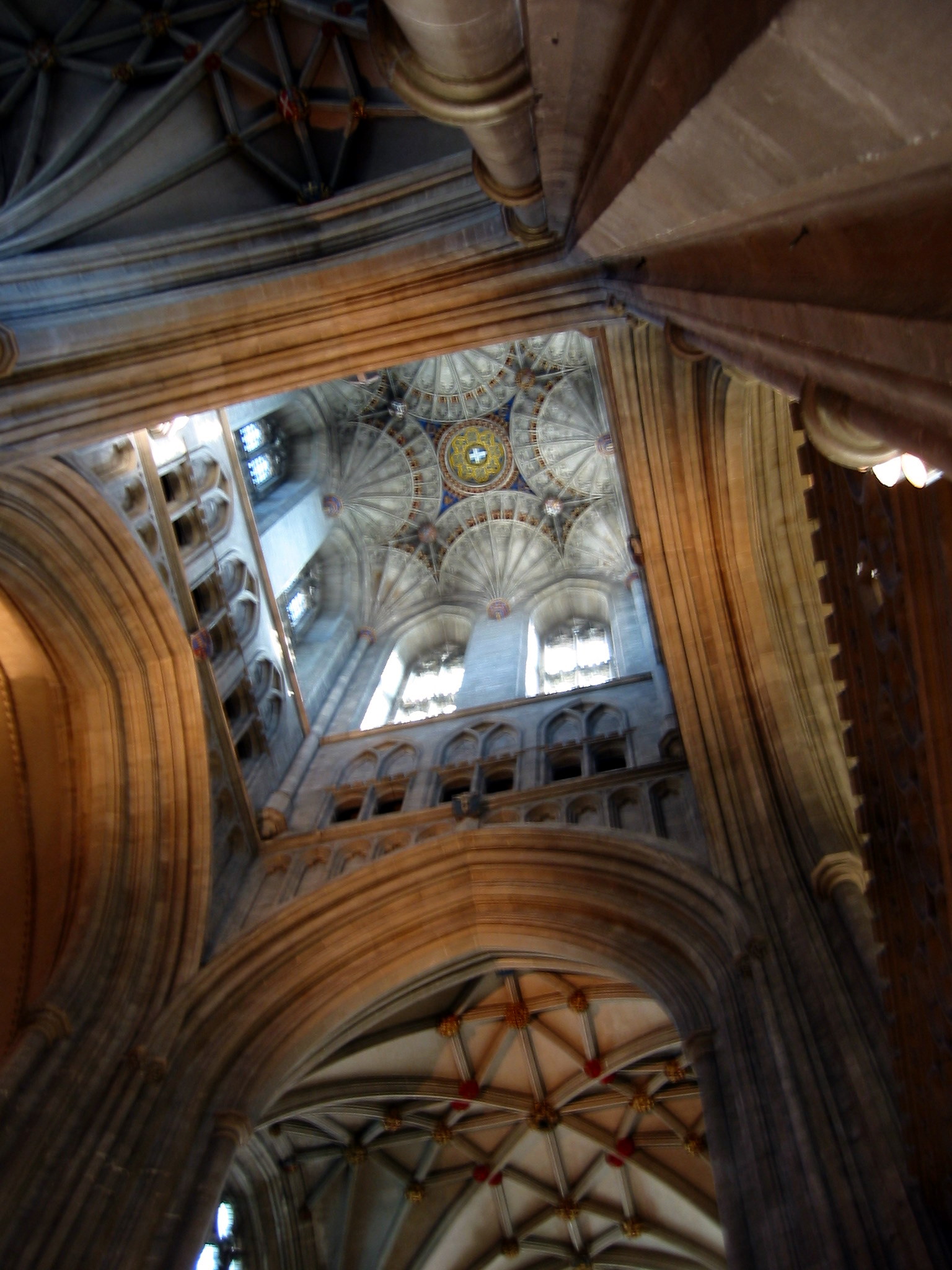
There had been Christians in
Canterbury in Roman times and a cathedral, which Augustine rehallowed in
602. About 150
years later Archbishop Cuthbert added a second building as a baptistery
and place for the burial of archbishops. That
building no longer exists. In
1011 Canterbury was burned when the Danes invaded. In
1067 the cathedral again burned beyond repair by a fire in the city. In
1077 a new cathedral was built by Lanfranc in the Romanesque style. When
Anselm became Archbishop in 1093, he added the towers, a crypt and an
extensive choir. Again
fire struck in 1174. The
next year the monks choose William of Sens to begin rebuilding the choir
in the new Gothic
style. Unfortunately
in 1178 William fell while working on a high vault and was permanently
injured. His
work was completed by William the Englishman. In
1377 the old Romanesqu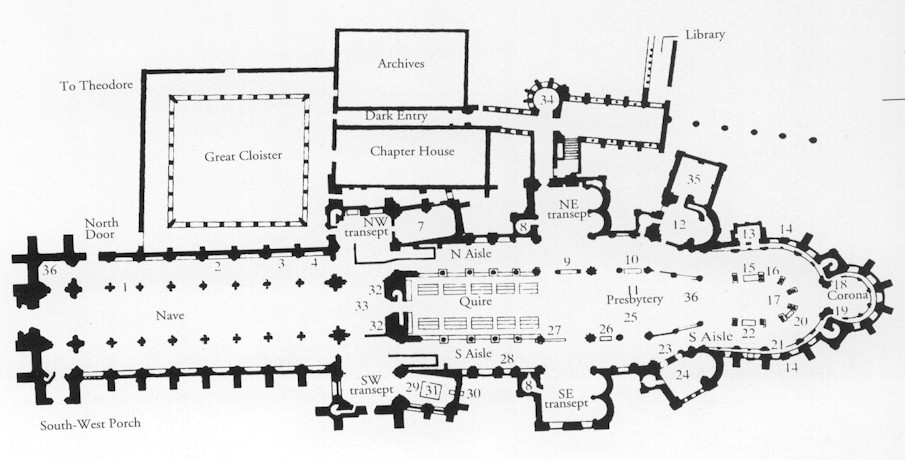
e nave was demolished and new one was built in the early
Perpendicular Gothic style. The
Perpendicular style’s emphasis was upon height and masses of vertical
line branching upward into the sprays of rib-vaulting. This
was completed in 1405, taking 28 years to finish. In
1414 the southwest transept for completed and the northwest transept in
1468. The Bell
Harry bell tower was completed in 1494.
Up until the time of the English
Reformation under Henry VIII in 1509, Canterbury Cathedral was under the
authority of the Roman Church and the Pope. With
Henry’s break from the Pope and the Church, the churches in England
became part of the Anglican Church or the Church of England as they are
today. The Archbishop of Canterbury remains the spiritual head of the
Church of England and
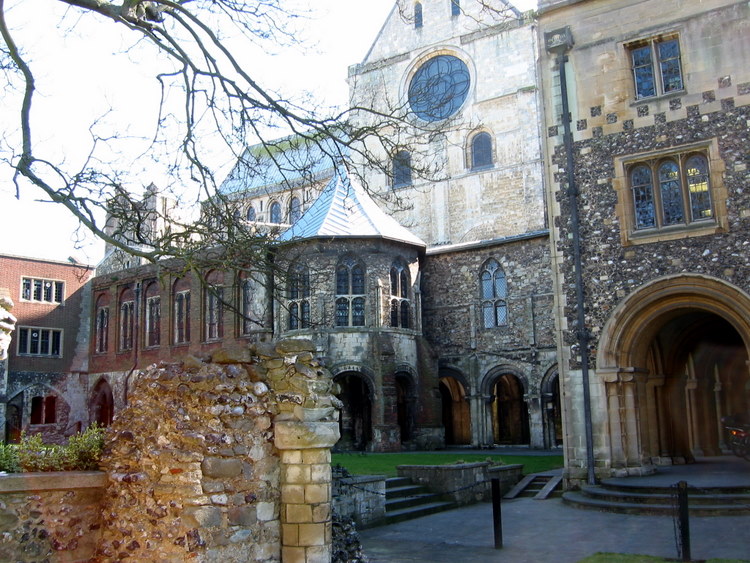 the
world-wide Anglican Communion.
the
world-wide Anglican Communion.
Our guides gave us an exceptional tour
emphasizing all of the history and architectural of various parts of the
cathedral. Unlike
St. Paul’s and Westminster Abbey, we were allowed to take 
photos inside except for the crypt areas where flash could damage the
old paintings. Like
many Gothic churches
we will visit on our quest, Canterbury had a chapel behind the high
altar in the Apse. This
chapel, Trinity Chapel, was located in the Apse. It was in this chapel
that the shrine for Thomas Becket was placed from 1220 until its
destruction in 1538.
Trinity
Chapel,
at the eastern extremity of the Cathedral, is now dedicated to the
Saints and Martyrs of Our Time. Originally it contained a relic of the
part of Thomas' skull which was cut off when he was martyred.
There are volumes that have been written
about the history and architecture of Canterbury cathedral, from the Romanesque chapels
in the crypt to the soaring perpendicular columns, the nave and choir,
the exquisite stained glass windows, and the tombs and monuments to the
clerical and royal champions of English history.
After the tour, we did a little shopping. We
were cold, and we didn’t expect England to be so cold in April. I
bought a green plaid scarf. We
went back to the cathedral for Evensong in the choir. The students in
the cathedral schools were on spring vacation so Evensong was said.
We had dinner in the tea room of the hotel.
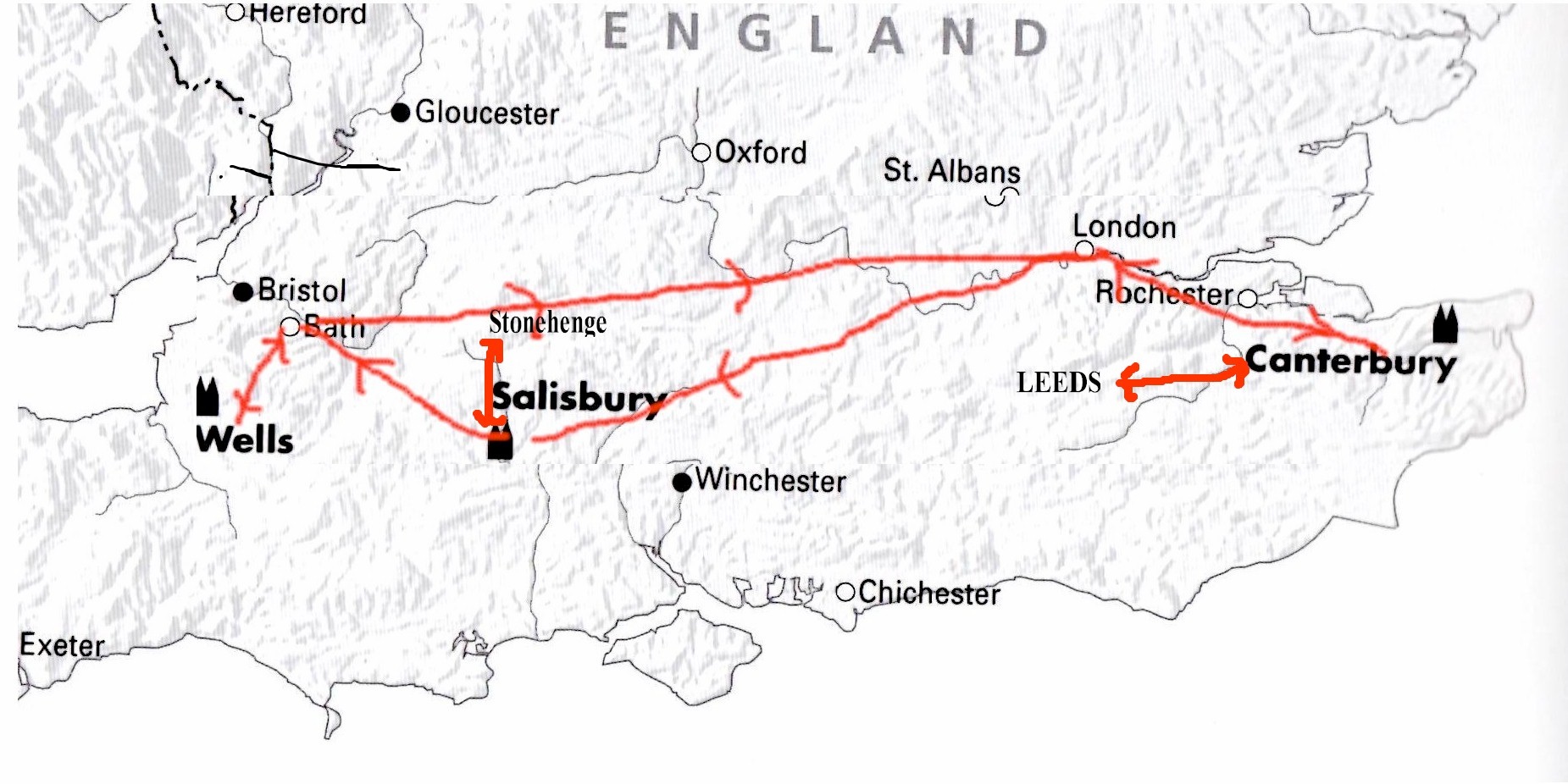
Return to Facebook -
www.facebook.com/thomasclay.3591
 train,
and had to change trains at Faversham. We
arrived in Canterbury and took a taxi to the hotel.
train,
and had to change trains at Faversham. We
arrived in Canterbury and took a taxi to the hotel.  The room was small with a large bed. The
view was unbelievab
The room was small with a large bed. The
view was unbelievab l
l It was a nice day. There
were several groups of students in the square outside our hotel waiting
to take a tour of the cathedral. We found a little
cafeteria in the basement of a building across from the cathedral gate. We
were served rather than self service. We
love to tell the story about the young man serving us, who asked us if
we wanted “pies” with our meal. We
couldn’t understand what he was saying so he took the top off the
serving pan and there were “peas”. As
a fond remembrance of this experience, we most always call peas “pies”
when we serve them for dinner. After lunch we shopped around waiting for
our appointment time at the cathedral.
It was a nice day. There
were several groups of students in the square outside our hotel waiting
to take a tour of the cathedral. We found a little
cafeteria in the basement of a building across from the cathedral gate. We
were served rather than self service. We
love to tell the story about the young man serving us, who asked us if
we wanted “pies” with our meal. We
couldn’t understand what he was saying so he took the top off the
serving pan and there were “peas”. As
a fond remembrance of this experience, we most always call peas “pies”
when we serve them for dinner. After lunch we shopped around waiting for
our appointment time at the cathedral.
 some of the history as she led us to the office of the person in
charge of the vestments (vestiturer). He
had an office in what was known as the ‘candle room”. There
was a small window that looked down on a chapel in the crypt below. He
told us that this was the room where the monks stayed to watch the body
of the murdered Thomas a Becket which was in the chapel below. One
of the cathedral canons joined us at this point. We
went into the vestment room or sacristy. The
vestiturer showed us all the old altar hangings and vestments. In
one closet was the cope of the Archbishop of Canterbury. The
cope is the final vestment that a bishop wears during religious
ceremonies. It looks like a big cape. He
had me put it on and have my picture taken. The
three of our guides continued to give us our private tour of the
Canterbury Cathedral.
some of the history as she led us to the office of the person in
charge of the vestments (vestiturer). He
had an office in what was known as the ‘candle room”. There
was a small window that looked down on a chapel in the crypt below. He
told us that this was the room where the monks stayed to watch the body
of the murdered Thomas a Becket which was in the chapel below. One
of the cathedral canons joined us at this point. We
went into the vestment room or sacristy. The
vestiturer showed us all the old altar hangings and vestments. In
one closet was the cope of the Archbishop of Canterbury. The
cope is the final vestment that a bishop wears during religious
ceremonies. It looks like a big cape. He
had me put it on and have my picture taken. The
three of our guides continued to give us our private tour of the
Canterbury Cathedral.  Canterbury
Cathedral is about the same size as the Washington Cathedral.
The profile on the left is the Washington Cathedral which is 100 feet
high compared with Canterbury which is only 70 feet high. Both
cathedrals, which are Gothic in
style have an open triforium and
stained glass windows in the clerestory.
Canterbury
Cathedral is about the same size as the Washington Cathedral.
The profile on the left is the Washington Cathedral which is 100 feet
high compared with Canterbury which is only 70 feet high. Both
cathedrals, which are Gothic in
style have an open triforium and
stained glass windows in the clerestory. 

 e nave was demolished and new one was built in the early
Perpendicular Gothic style. The
Perpendicular style’s emphasis was upon height and masses of vertical
line branching upward into the sprays of rib-vaulting. This
was completed in 1405, taking 28 years to finish. In
1414 the southwest transept for completed and the northwest transept in
1468. The Bell
Harry bell tower was completed in 1494.
e nave was demolished and new one was built in the early
Perpendicular Gothic style. The
Perpendicular style’s emphasis was upon height and masses of vertical
line branching upward into the sprays of rib-vaulting. This
was completed in 1405, taking 28 years to finish. In
1414 the southwest transept for completed and the northwest transept in
1468. The Bell
Harry bell tower was completed in 1494.



